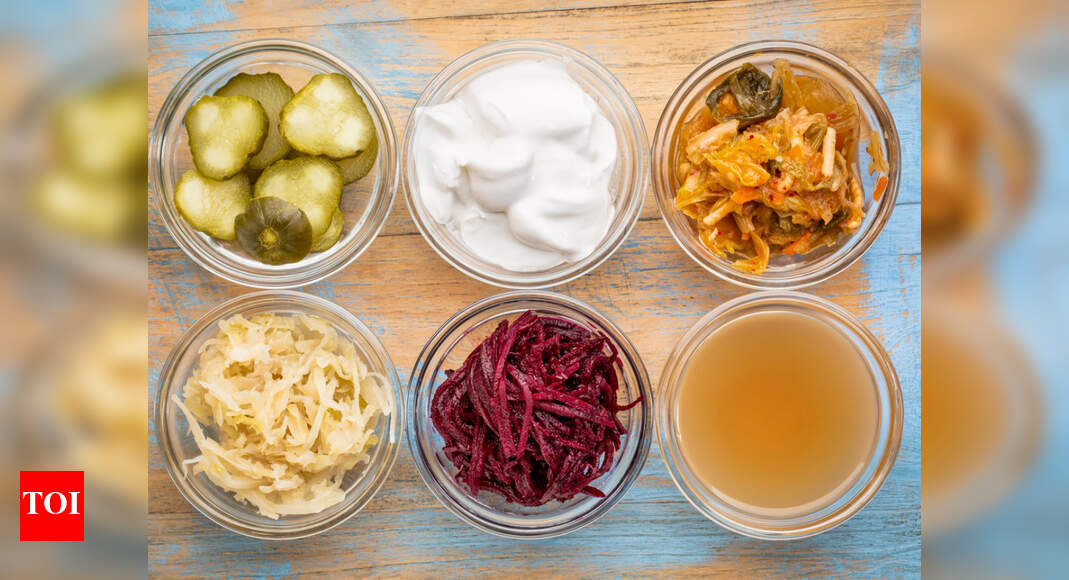You can get probiotics with supplements, but you can also get them with fermented foods. Here is the list of the most popular probiotic foods.
Yogurt
Yogurt is one of the best sources of probiotics, which contains friendly bacteria and can improve your health. Eating yogurt is associated with several health benefits, including bone health and lowers high blood pressure.
In children, yogurt can help reduce diarrhea caused by antibiotics. It can also relieve the symptoms of irritable bowel syndrome (IBS).
It is also a good option for people with lactose intolerance. But not all yogurt contains live bacteria; in some cases, the bacteria were killed during processing.
So be sure to choose yogurt from live and active cultures.
Sauerkraut
Sauerkraut is finely chopped cabbage that has been fermented by lactic acid bacteria. It is an ancient food tradition common in Europe. It is used as a side dish and tastes sour and salty, and can be stored for months in an airtight container.
In addition, sauerkraut is rich in fiber and vitamins C, B and K. It is rich in sodium and contains manganese and iron.
It has antioxidants lutein and zeaxanthin, important for eye health.
Be sure to choose unpasteurized sauerkraut, as pasteurization kills live, active bacteria.
Kimchi
Kimchi is a spicy and fermented Korean dish. Cabbage is the main ingredient of the dish, but it can also be made with other vegetables. It is full of flavors and has various spices such as chili pepper flakes, garlic, ginger, salt and chives.
Kimchi is good for digestive health and has the lactic acid bacteria Lactobacillus Kimchii.
Kombucha
The drink is now part of the menus of several cafes and restaurants. It is a fermented black or green tea. It has friendly bacteria and yeasts and is consumed in various parts of the world.
Cucumbers
Also called pickles, cucumbers are cucumbers that have been preserved in a solution of salt and water. These are left to ferment for some time, using their own lactic acid bacteria. The process makes them taste sour.
Pickled cucumbers are healthy probiotic bacteria, which can improve digestive health. They are low in calories and a good source of vitamin K. They are also high in sodium. Also, remember that pickles that contain vinegar do not contain live prebiotics.
Traditional buttermilk
There are two types of traditional buttermilk and culture. Traditional buttermilk is simply the residual liquid from making butter. This version has a probiotic and is also called ‘grandma’s probiotic’.
Traditional buttermilk is consumed in Nepal, Pakistan and India.
Cultured buttermilk has no probiotic benefit and is found in supermarkets.
Buttermilk is low in fat and calories and contains important vitamins and minerals such as B12, riboflavin, calcium and phosphorus.
Some types of cheese
Although most types of cheese are fermented, this does not mean that they all contain probiotics. It is important to look for live and active cultures on food labels. Good bacteria can survive the aging process in some cheeses, including mozzarella, gouda, cheddar and cottage cheese.
Cheese is nutritious and a great source of protein. It is also rich in important vitamins and minerals, including vitamin B12, calcium, selenium and phosphorus.
Moderate consumption of dairy products like cheese can reduce the risk of heart disease and osteoporosis.
Tempeh
Tempeh is a fermented soy product. It is a firm hamburger whose flavor is described as nutty, earthy and mushroom-like.
It is a meat substitute with a high protein content and is famous worldwide. The fermentation process has surprising effects on its nutritional profile.
Soy is rich in phytic acid, which impairs the absorption of minerals such as zinc and iron. But the fermentation process decreases the amount of phytic acid, which can increase the mineral’s absorption.
Fermentation also produces some vitamin B12, which soybeans would not otherwise have.
Vitamin B12 is found mainly in foods of animal origin such as meat, fish, dairy products and eggs. This makes tempeh a great choice for vegetarians who want to add a nutritious probiotic to their diet.
